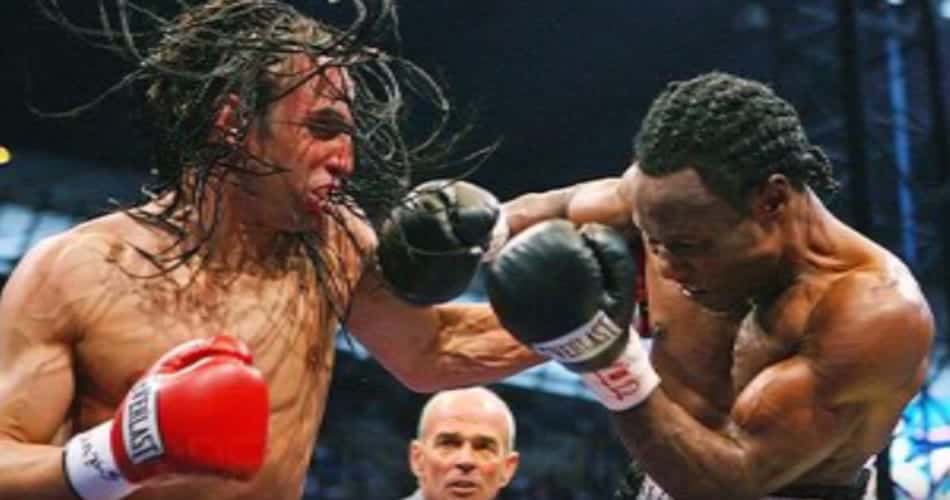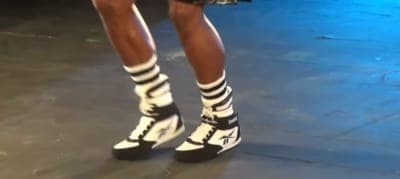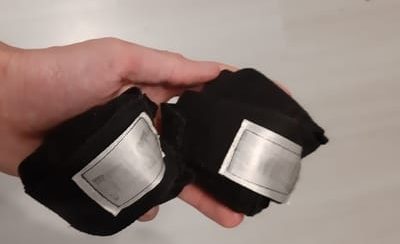
I’ve always had short hair but recently I noticed that girls (or guys with long hair) have some real problems while training for boxing. When boxing, you will need to keep your chin tucked and this is where long hair can present a challenge.
If you have long hair that is not secured, it will be able to flop forward into your face and block your vision. Also, it’s not that great to be a sparring partner of someone with long hair because it can flap around and get into your face and mouth.
So I did some research and spoke with some pro boxers with long hair and here are my 7 tips for the boxers with long hair:
- Use multiple hair ties at the same time
- Use mousse or gel to keep fly-away hair in place
- Pull your hair into a tight top-knot
- Twist your hair into a bun on the very top of your head
- Braid your hair tightly over your head and tuck it into a bun
- Avoid using hard pins
- Use a hair net
Below we take a closer look at each of those 7 tips and other important stuff you need to know if you want to box with long hair.
But even if you follow them, your vision can still be somewhat blocked during sparring, not because of your hair but because of your headgear. Most headgear blocks your peripheral vision which really sucks because you take a lot of unnecessary punches to the head.
So to make sure that doesn’t happen, I highly recommend checking out my article on the Top 7 Headgear for Good Vision (opens in a new tab). You don’t have to read the whole thing, just check my top recommendations.
Now, let’s get back to the tips!
Training for Boxing with Long Hair
Training for boxing with long hair is fairly simple. You don’t need to cut it off; you just need to learn a few techniques for securing your hair away from your face. One of the first things you need to do is ensure that you are always carrying spare hair ties with you. This is probably one of the biggest pieces of advice that can be shared with you.
Pack a few spare hair accessories in your training kit, to ensure that you are always prepared. If your hair tie falls out or snaps, you don’t want to have to waste time hunting for it, so having spares on hand makes better sense.
1. Use multiple hair ties at the same time when tying your hair up
Some boxers like to tie their hair into a high ponytail and braid/plait it to keep it under control. This is a great strategy, except that it does not always work. The only problem that is encountered with this is that the hair tie can slide out, leaving the hair to fall in the boxer’s face. It is important to secure the hair with more than one hair tie. Using multiple hair ties can help to eliminate the problem. Two or three hair ties at the base of the pony-tail braid should be sufficient to keep the hair neatly in place.
2. Use hair mousse or gel to keep fly-away hair in place
One of the biggest problems when training for boxing with long hair is that it is hard to keep hair in place when moving around. Strands of hair will often fall out of the hair tie. One way to ensure that hair remains out of your face is to comb some strong hold mousse or hair gel into it before tying it up. Make sure that you use sufficient hair product to keep your hair firmly in place.
3. Pull your hair into a tight top knot to keep it in place, out of your face
A top knot is extremely strong. When you use a top knot for training, you should find that it doesn’t pull out of place easily. You can tie a firm, double-twisted top knot for boxing by following these steps:
- Pull all of your hair up into a tight ponytail on the very top of your head and secure it with a material hair tie.
- Split your ponytail hair into two sections.
- Wrap one section of hair around the other and tie it into a knot.
- Pull the knot extra tight to secure it.
- Take both of the long sections of hair and tie them again to form a second knot. You now have a double knot.
- Now, wrap the leftover length of hair around the bun and secure it with a hair tie. Use a second hair tie to ensure that your top knot is extra strong.
Now your hair is secure and shouldn’t fall out during training.
4. Twist your hair into a bun on the very top of your head and secure it
A traditional bun at the back of the head is not a good idea for boxing. It is better to get all of your hair right up and out of the way so that your movements feel completely unhindered. To tie a tight bun on top of your head, bend over and gather all of your hair on the very top of your head. Secure your hair into a ponytail with a hair tie. Make sure that you tie it tight enough so that it does not slip out. Twist your hair around the hair tie a number of times, until it forms a bun. Secure the bun in place with two hair ties.
5. Braid your hair tightly over your head and tuck it into a bun
A braid is a firm favorite, especially for female boxers. If you opt for a braid, it is best to start it at the very top of your head and to do it as tightly as possible. Braid it very tightly, right down to the base of your skull (nape of your neck). If you have any remaining hair, plait it until the end and secure it with a hair tie. You can then twist the bottom of the braid into a bun and secure with an additional hair tie. Your hair shouldn’t move anywhere during training.
6. Avoid using hard pins in your hair
It is important to only use non-abrasive soft material hair ties and pins to secure your hair as per the regulations set in place by the Association of Boxing Commission & Combative Sports. Of course, the reason for this to ensure that neither boxer gets hooked, scratched, or hurt by boxer hair accessories. Accidents can happen during a fight.
7. Use a hair net
If you are still worried about hair falling down or your hair ties slipping out, you can opt to wear a hair net. Wearing a hair net provides a second layer of protection. You can find this in most toiletry and personal care aisles in the supermarket. Simply wrap your hair into a very tight bun and secure a hair net over it.
Competing with long hair
According to the Association of Boxing Commission & Combative Sports, boxers are allowed to train with long hair, as long as it is pulled and secured away from the eyes and face. Their regulations state that “hair shall be secured with soft non-abrasive materials when deemed appropriate by an official from the supervising commission”.
Why it is Important to Secure Long Hair When Boxing
There are obvious reasons why you should secure your hair when boxing if it is long. First and foremost, you want to keep your hair out of your eyes, so that you can see what you are doing. You also do not want your sweaty hair making contact with your opponent. These facts are true, but there is more to it than that. Another reason that boxers with long hair are worried about securing their hair neatly is because of competition judges.
In competitions, the judges will be taking close notice of how a boxer responds to knocks. If your hair is not secured and falls out and into your face, it can appear as if you are being hit with a much harder force than you are. Judges will notice more so when the boxer moves his/her head when he gets hit (or not).
Short Hair is Most Common among Pro Boxers
If you are not planning on becoming a professional boxer, you might not want to cut your hair for the love of the sport. That is okay because there are ways that you can secure your hair so that it does not impact negatively on your technique or effectiveness as a boxer. Most pro boxers cut their hair very short or even shave it for the following reasons:
- Short hair is generally easier to care for and maintain.
- Some believe it is a way of becoming more streamlined and contributes to weight requirements.
- Short hair can sometimes look more aggressive or threatening.
Last Word
Your training for boxing doesn’t have to be delayed or thwarted just because you are attached to your long hair. By securing and tying your hair effectively, you can box with long hair with ease.



